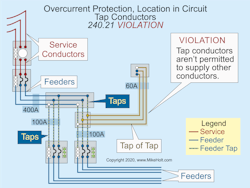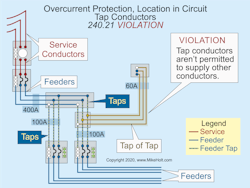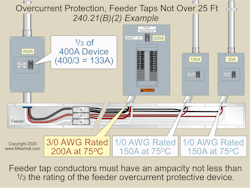Courtesy of www.MikeHolt.com.
Based on the 2020 NEC.
There are a lot of variables when it comes to electrical installations. One reason you might tap a feeder is because you need to supply a specific load, and there’s already a feeder in the area with ample ampacity to also supply this load. Rather than expend the labor, time, and materials to run another feeder circuit, you tap into the nearby feeder. If you do tap a feeder, overcurrent protection must be provided for each phase conductor at the point where the conductors receive their supply, except as permitted by Sec. 240.21(A) through (H).
If you think about this for a moment, you see that the feeder overcurrent protective device (OCPD) is oversized for the tap conductor — that is, the conductor has overcurrent protection rated more than the ampacity of the tap conductor because its OCPD is sized for the feeder you tapped.
Instead of being protected at the point where they receive their supply, tap conductors are protected against an overload by the OCPD into which they feed and against short circuit/ground fault by the feeder protective device from which they originate.
We also know you can’t tap a tap for the simple reason the tap you would be tapping does not have its own OCPD. This situation creates other limitations that the Code addresses, which we will look at shortly (Fig. 1).
Conductors can be tapped without overcurrent protection at the tap, as specified in Sec. 240.21(B)(1) through (B)(5). Notice, there is no mention here of tapping to a tap. The reference is always to the feeder. For example, “Except at the point of the connection to the feeder…” [Sec. 240.21(B)(1)(3)] and “The ampacity of the tap conductors is at least one-third the rating of the overcurrent device protecting the feeder conductors” [Sec. 240.21(B)(2)(1)].
The tap is permitted at any point on the load side of the feeder OCPD. The “next size up” rule in Sec. 240.4(B) is not permitted for feeder tap conductors.
(1) Feeder Tap Not Over 10 Feet. Tap conductors up to 10 ft long are permitted when they comply with the following:
(1) Tap conductors have an ampacity equal to or greater than:
a. The calculated load per Art. 220, and
b. The rating of the OCPD or the equipment supplied by the tap conductors.
(2) The tap conductors are not permitted to extend beyond the equipment they supply.
(3) The tap conductors are installed within a raceway.
(4) Tap conductors that leave the enclosure where the tap is made must have an ampacity of at least 10% of the rating of the OCPD that protects the feeder.
Informational Note: If a tap supplies a panelboard, the tap conductors must terminate in an OCPD per Sec. 408.36.
10-ft tap rule
The length of your tap determines which rules to apply to it. When a tap is not over 10 ft, you determine the tap conductor size using the 10-ft tap rule. There are four rules for 10-ft taps, but it’s the first of those four [Sec. 240.21(B)(1)(1)] you follow when sizing the tap conductors:
The ampacity of the tap conductors must be at least the:
- Combined calculated loads on the circuits supplied by the tap conductors [Sec. 240.21(B)(1)(a)], and
- Rating of the equipment containing an OCPD supplied by the tap conductors or (at least the) rating of the OCPD of the tap conductors.
Let’s run through some examples to clarify how you apply these requirements.
Example 1
Question: What size 10-ft tap conductor is needed from a 400A circuit breaker to supply a 200A panelboard if the terminals are rated 75°C, as shown in Fig. 2?
(a) 1/0 AWG
(b) 2/0 AWG
(c) 3/0 AWG
(d) 4/0 AWG
Solution: Ten Percent of 400A = 40A minimum conductor ampacity permitted
3/0 AWG is rated 200A at 75°C [Sec. 110.14(C)(1)(b)(2) and Table 310.16], which is greater than 10% of the rating of the 400A OCPD.
Answer: (c) 3/0 AWG
Example 2
Question: What size 10-ft tap conductor is needed from a 400A circuit breaker to supply a 150A feeder disconnect if the terminals are rated 75°C?
(a) 1/0 AWG
(b) 2/0 AWG
(c) 3/0 AWG
(d) 4/0 AWG
Solution: Ten Percent of 400A = 40A minimum conductor ampacity permitted
1/0 AWG is rated 150A at 75°C [Sec. 110.14(C)(1)(b)(2) and Table 310.16], which is greater than 10% of the rating of the 400A OCPD.
Answer: (a) 1/0 AWG
Example 3
Question: What size 10-ft tap conductor is needed from a 400A circuit breaker to supply a 30A feeder disconnect if the terminals are rated 75°C?
(a) 8 AWG
(b) 6 AWG
(c) 4 AWG
(d) 3 AWG
Solution: Ten Percent of 400A = 40A minimum conductor ampacity permitted
8 AWG is rated 50A at 75°C [Sec. 110.14(C)(1)(a)(3) and Table 310.16], which is greater than 10% of the rating of the 400A OCPD.
Answer: (a) 8 AWG
25-ft tap rule
Tap conductors up to 25 ft long are permitted when they comply with the following:
(1) The tap conductor has an ampacity of at least 1⁄3 the rating of the OCPD that protects the feeder.
(2) The tap conductors terminate in an OCPD and have an ampacity equal to or greater than the rating of the OCPD.
Notice how this differs from the 10-ft tap rule. It’s shifted from being based on the load the tap feeds to being based on the rating of the feeder OCPD.
Let’s run through some examples to clarify how you apply these requirements.
Example 1
Question: What size 25-ft tap conductor is needed from a 400A circuit breaker to supply a 200A panelboard if the terminals are rated 75°C, as shown in Fig. 3?
(a) 1/0 AWG
(b) 2/0 AWG
(c) 3/0 AWG
(d) 4/0 AWG
Solution: The tap conductor must have a minimum rating of at least 133A (1⁄3 the rating of the 400A OCPD).
3/0 AWG is rated 200A at 75°C [Sec. 110.14(C)(1)(b)(2) and Table 310.16], which is greater than 133A (1⁄3 the rating of the 400A OCPD) and equal to the 200A disconnect.
Answer: (c) 3/0 AWG
Example 2
Question: What size 25-ft tap conductor is needed from a 400A circuit breaker to supply a 150A feeder disconnect if the terminals are rated 75°C?
(a) 1/0 AWG
(b) 2/0 AWG
(c) 3/0 AWG
(d) 4/0 AWG
Solution: The tap conductor must have a minimum rating of at least 133A (1⁄3 the rating of the 400A OCPD).
1/0 AWG is rated 150A at 75°C [Sec. 110.14(C)(1)(b)(2) and Table 310.16], which is greater than 133A (1⁄3 the rating of the 400A OCPD) and equal to the 150A disconnect.
Answer: (a) 1/0 AWG
Example 3
Question: What size 25-ft tap conductor is needed from a 400A circuit breaker to supply a 30A feeder disconnect if the terminals are rated 75°C?
(a) 3 AWG
(b) 2 AWG
(c) 1 AWG
(d) 1/0 AWG
Solution: The tap conductor must have a minimum rating of at least 133A (1⁄3 the rating of the 400A OCPD).
1/0 AWG is rated 150A at 75°C [Sec. 110.14(C)(1)(b)(2) and Table 310.16], which is greater than 133A (1⁄3 the rating of the 400A OCPD) and greater than the 30A disconnect.
Answer: (d) 1/0 AWG
Outside feeder taps
Outside tap conductors can be of unlimited length if they comply with all of the following [Sec. 240.21(B)(5)]:
(1) The outside tap conductors are protected from physical damage.
(2) The outside tap conductors terminate in a single circuit breaker or a single set of fuses that limits the load to the ampacity of the conductors.
(3) The tap’s OCPD is part of the building feeder disconnect.
Happy tapping
If you decide to tap a feeder, you can reduce the cost if you can keep the tap to 10 ft or less. Since doing so is often not possible, you have to follow the more stringent rules for longer taps.
From a documentation standpoint, taps can add complexity and confusion. In your CAD drawings, use notes, comments, and/or labeling to make it clear which feeder (and thus breaker) supplies a given tap. Adding similar information to the equipment itself and (for maintenance departments) in the computerized maintenance management system (CMMS) for the affected assets will also help avoid errors with lockout/tagout.
These materials are provided to us by Mike Holt Enterprises in Leesburg, Fla. To view Code training materials offered by this company, visit www.mikeholt.com/code.
About the Author

Mike Holt
Mike Holt is the owner of Mike Holt Enterprises (www.MikeHolt.com), one of the largest electrical publishers in the United States. He earned a master's degree in the Business Administration Program (MBA) from the University of Miami. He earned his reputation as a National Electrical Code (NEC) expert by working his way up through the electrical trade. Formally a construction editor for two different trade publications, Mike started his career as an apprentice electrician and eventually became a master electrician, an electrical inspector, a contractor, and an educator. Mike has taught more than 1,000 classes on 30 different electrical-related subjects — ranging from alarm installations to exam preparation and voltage drop calculations. He continues to produce seminars, videos, books, and online training for the trade as well as contribute monthly Code content to EC&M magazine.




